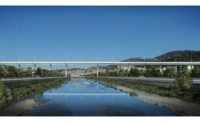 Speedway Motorsports Inc. Banked surface placed in less than five months.
|
NASCAR is known for its fast cars, but it now can also be known for its fast construction. Crews this week are set to complete the pour of a .53-mile, 40-ft- wide continuously reinforced concrete track for Tennessee’s Bristol Motor Speedway. Demolition of the old track occurred on March 26.
Speedy construction is needed because nearly 160,000 racing fans have already purchased tickets for NASCAR’s Sharpie 500, scheduled to be held on the track Aug. 25. “Canceling a NASCAR race is not an option,” says John Zudell, senior construction manager for Speedway Motorsports Inc., Concord, N.C., the facility owner overseeing the $8 million overhaul.
The old track’s concrete surface had four jointed segments. The surface could not withstand the stress of drastic temperature fluctuations and gradients of up to 50%. During such changes, track segments would push against each other at the joints—hard enough “to launch cantaloupe-sized chunks over 100 feet,” says Zudell. SMI opted for continuously reinforced concrete because it will allow the surface to move incrementally.
The 10-acre surface area inside the stadium is being overhauled. SMI decided to increase the gradient of the banks from a 50% to a 57% maximum gradient and install a pedestrian tunnel leading to the infield. Baker Construction Services, Bluff City, Tenn., has a $2.5-million earthmoving contract, including excavation for the 9-ft-wide, 8-ft-high, 170-ft-long precast concrete tunnel.
Baker used a GPS-guided grader to grade the subsurface. Crews placed 13,000 sq yd of concrete for the base of the oval track and covered it with a 17-in.-thick concrete layer placed within rebar spaced every 4.5 inches. “It’s a very thick mat of steel,” says Rob Ford, project coordinator with Baker Concrete Construction, Monroe, Ohio. (The firm is unrelated to Baker Construction Services.)
One of the challenges in the $5-million contract “is that the slope of track is from 15% to 57% on the turns,” says Ford. “The engineers needed to put a product up on that slope to withstand all of the stresses.” The new track is surrounded by 2,900 ft of perimeter steel-and-foam crash barriers.
Baker Concrete used a finisher provided by Gomaco, Ida Grove, Iowa, to handle the parabolic slope. Baker Concrete placed the customized finisher on rails installed around the track. “We put one rail at the top of the track on the track wall and one just off the surface to the inside,” says Ford.
The saw-cutting design called for 5-ft-on-center cuts in the 650-ft-long straightaways and 10-ft-on-center cuts in the 910-ft-long turns. “Due to the steep slopes, we built a custom rig, which used a modified softcut saw with an electric motor and a truss system to guide and transport the saw,” says Ford.



Post a comment to this article
Report Abusive Comment